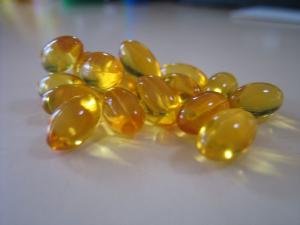Extracting bioactive compounds from marine microalgae

Fish oil has high levels of omega-3s but with declining fish stocks, it is imperative to find alternative sources Copyright : Wikimedia
Microalgae are photosynthetic microorganisms that produce high value compounds considered essential for human health, including polyunsatured fatty acids (e.g., omega-3s like EPA and DHA), various pigments (chlorophyll and carotenoids), and vitamins. Although fish have traditionally been our principal dietary source of EPA and DHA, declining marine fish stocks, the unpleasant odour of fish oil, and other disadvantages, have prompted a search for alternative sources of these nutrients.
In a study, published in the Pertanika Journal of Tropical Agricultural Science, S. P. Loh and S. Lee of the Universiti Putra Malaysia evaluated various methods for extracting fatty acids and carotenoids from two microalgae species: Chaetoceros gracillis, a diatom, and Nannochloropsis occulata, a unicellular green alga. Both species play an important role in the food chain, while N. occulata is also widely cultivated for fish hatcheries and shrimp farms.
No standard extraction methods currently exist for determining the fatty acid or carotenoid content of microalgae. Therefore, the researchers selected different extraction methods based on these criteria: maximum extraction efficiency, ease of handling, and use of solvents of low toxicity.
Overall, the study found that high amounts of fatty acids and carotenoids could be obtained from both microalgae. However, for both fatty acid and carotenoid extration, one extraction method was superior in N. occulata while another method yielded the best results in C. gracillis.
The researchers also found that N. occulata had higher amounts of the omega-3 fatty acid EPA, while C. gracillis was particularly high in palmitic acid and palmitoleic acid levels. In addition, there were significantly higher carotenoid levels in N. occulata compared to C. gracillis.
For more information about this research, please contact:
S. P. Loh
Department of Nutrition and Dietetics
Faculty of Medicine and Health Sciences
Universiti Putra Malaysia
3400 Serdang, Selangor, Malaysia
Email: sploh@upm.edu.my
Tel: +(603) 8947 2432; Mobile: +(6012) 391 2654.
About Pertanika Journal of Tropical Agricultural Science (JTAS)
Pertanika Journal of Tropical Agricultural Science (JTAS) is published by Universiti Putra Malaysia in English and is open to authors around the world regardless of nationality. The journal is published four times a year in February, May, August and November. Other Pertanika series include Pertanika Journal of Science & Technology (JST), and Pertanika Journal of Social Sciences & Humanities (JSSH).
JTAS aims to provide a forum for high quality research related to tropical agricultural research. Areas relevant to the scope of the journal include: agricultural biotechnology, biochemistry, biology, ecology, fisheries, forestry, food sciences, entomology, genetics, microbiology, pathology and management, physiology, plant and animal sciences, production of plants and animals of economic importance, and veterinary medicine. The journal publishes original academic articles dealing with research on issues of worldwide relevance.
For more information about the journal, contact:
The Chief Executive Editor (UPM Journals)
Head, Journal Division, UPM Press
Office of the Deputy Vice Chancellor (R&I)
IDEA Tower 2, UPM-MDTC Technology Centre
Universiti Putra Malaysia
43400 Serdang, Selangor
Malaysia.
Phone: +(603) 8947 1622 | +(6016) 217 4050
Email: nayan@upm.my
Acknowledgements
The Chief Executive Editor, UPM Journals
Associated links
Link to research paper
Pertanika Journals
Media Contact
More Information:
http://www.researchsea.comAll latest news from the category: Agricultural and Forestry Science
Newest articles

NASA: Mystery of life’s handedness deepens
The mystery of why life uses molecules with specific orientations has deepened with a NASA-funded discovery that RNA — a key molecule thought to have potentially held the instructions for…

What are the effects of historic lithium mining on water quality?
Study reveals low levels of common contaminants but high levels of other elements in waters associated with an abandoned lithium mine. Lithium ore and mining waste from a historic lithium…

Quantum-inspired design boosts efficiency of heat-to-electricity conversion
Rice engineers take unconventional route to improving thermophotovoltaic systems. Researchers at Rice University have found a new way to improve a key element of thermophotovoltaic (TPV) systems, which convert heat…



